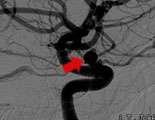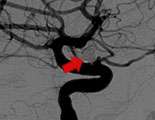Coil Embolization: Treating Aneurysm
Find your care
Radiologists are experts in all types of imaging, including advanced techniques.
Call today to find medical imaging near you and schedule your imaging procedure (MR, CT, PET, Dexa, Ultrasound).
Aneurysms of the Brain Can Be Deadly

An aneurysm is an abnormal widening or ballooning of a portion of an artery which is related to weakness in the wall of the blood vessel. If the aneurysm is not treated in time and ruptures, there is a 70% likelihood that the patient will either die or suffer a severe stroke that would prevent them from independent living. In the International Subarachnoid Aneurysm Trial (ISAT) study (a study comparing open surgical clipping versus the minimally invasive Coil Embolization in patients with ruptured aneurysms), patients treated with coil embolization did better in the long run than those with traditional surgical treatment.
The relative risk of death or significant disability at one year for patients treated with coil embolization was 22.6% lower than in surgically-treated patient.
- from ISAT study
Discovery of Aneurysms
However, many patients receive brain imaging for other reasons, and unruptured aneurysms are discovered. If the anatomy is suitable and if it is felt that the aneurysm does pose a risk for future rupture, the aneurysm can be treated with coil Embolization. Such was the case for this patient, Janet LaRue, who had episodes of confusion that led to an MRI of the brain which disclosed a left carotid-ophthalmic aneurysm. LaRue underwent an angiogram on the left side (Fig. 1) which confirmed the aneurysm.
Treatment of Aneurysms with Coil Embolization

Fig. 1: a lateral view of the left internal carotid artery before coil embolization.

Fig. 2: a lateral view of the left internal carotid artery after coil embolization.
To treat the aneurysm, LaRue was admitted to the hospital the morning of the procedure, and under general anesthesia, the aneurysm was embolized with detachable coils (Fig.2).
The procedure was done through the artery at the top of LaRue's right leg. The only evidence of treatment is a small bandage over the groin area. LaRue stayed overnight and was discharged the next day. LaRue has had followup studies which showed her aneurysm remained occluded.
Quick Links
- Patient Story: Understanding & Surviving a Stroke
- What is a Stroke?
- Interventional Neuroradiology
- MERCI Retriever
- Patient Referral
- Our Locations